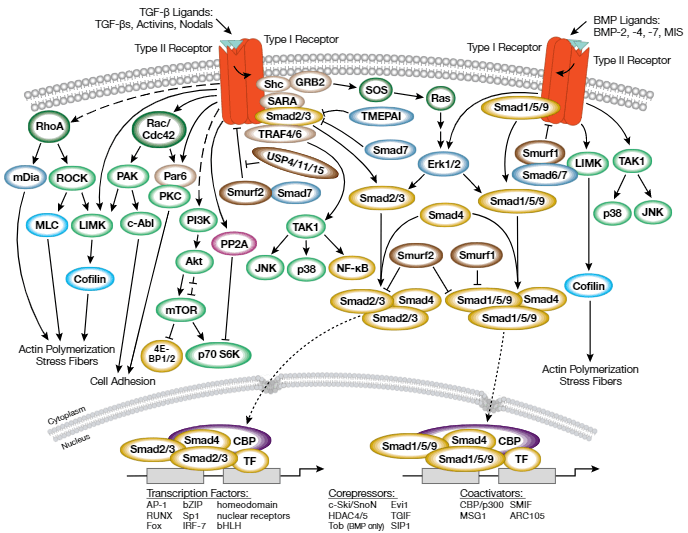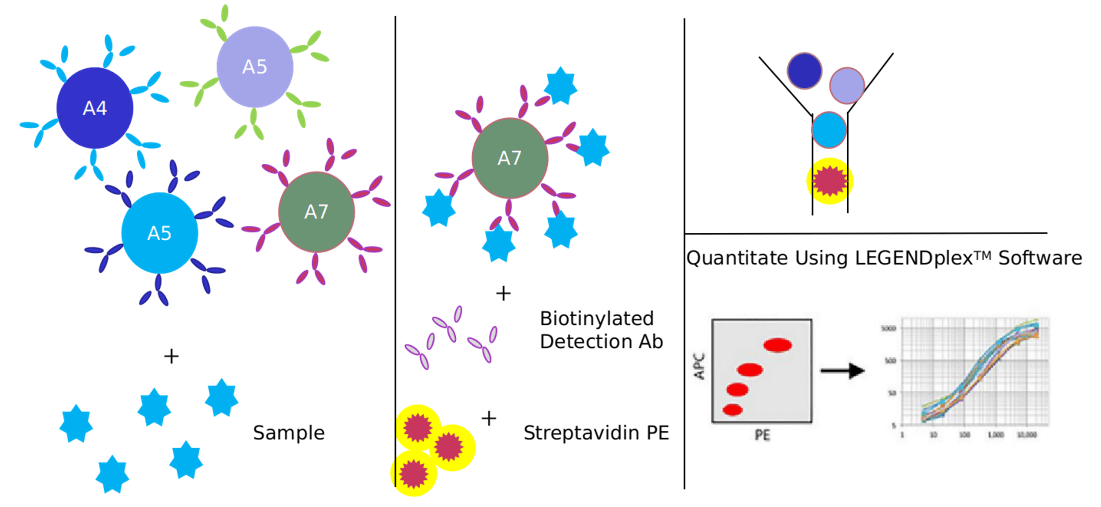TGF-β signaling pathway
Based on Luminex technology platform, Creative Proteomics provides analysis services for key targets of TGF-β signaling pathway.
The transforming growth factor beta (TGF-beta) superfamily signal transduction plays an important role in the regulation of cell growth, differentiation and development in many biological systems. Generally speaking, signal transduction starts with ligand-induced oligomerization of serine/threonine receptor kinases and phosphorylation of cytoplasmic signal transduction molecules, which are in the TGF-β/activin pathway It is Smad2 and Smad3, and in the bone morphogenetic protein (BMP) pathway it is Smad1/5/9. The carboxyl terminus of Smads is phosphorylated by the activated receptor, which causes it to bind to the common signal transduction factor Smad4 and is transported into the nucleus. Activated Smads can regulate various biological effects by binding to transcription factors, leading to specific transcriptional regulation of cell states. Inhibitory Smads, such as Smad6 and Smad7, can antagonize the activation of R-Smads. The expression of inhibitory Smads (I-Smads) 6 and 7 is induced by activin/TGF-β and BMP signal transduction together, as part of a negative feedback loop.

The stability of TGF-β family receptors and/or Smads is regulated by Smurf E3 ubiquitin ligase and USP4/11/15 deubiquitination enzyme. TGF-β/activin and BMP pathways regulate MAPK signal transduction at multiple levels. In addition, in some cases, TGF-β signal transduction can also affect Smad-independent pathways, including Erk, SAPK/JNK and p38 MAPK pathways. Rho GTPase (RhoA) activates downstream target proteins, such as mDia and ROCK, thereby promoting the remodeling of cytoskeletal molecules related to cell stretching, cell growth regulation, and cytokinesis. Cdc42/Rac regulates cell adhesion through downstream effector kinases PAK, PKC and c-Abl, and then activates TGF-β.
Our detectable targets:
| RhoA | Rac | Cdc42 | Shc | GRB2 | SOS |
| Ras | Smad1 | Smad5 | Smad9 | SARA | Smad2 |
| Smad3 | Smad7 | Smad4 | Smad6 | mDia | ROCK |
| PAK | Par6 | PKC | MLC | LIMK | C-Abl |
| Cofilin | PI3k | Akt | mTOR | TAK1 | S6k |
| PP2A | JNK | Smurf2 | p70 | p38 | NF-kB |
| Erk1 | Erk2 | LIMK | CBP | TMEPAI |
Technology platform
We provide Luminex technology for TGF-β signaling pathway analysis.
Luminex technology is a multifunctional liquid phase analysis platform developed on the basis of colored microspheres, laser technology, applied fluidics and high-speed digital signal processing technology. The core is to encode polypropylene microspheres or magnetic microspheres with fluorescent dyes. By adjusting the different ratios of the two fluorescent dyes, up to 100 microspheres with different fluorescence spectra can be obtained. Each kind of microspheres is covalently cross-linked. Capture antibodies against specific antigens.
Transforming growth factor-β (TGF-β) signaling plays a vital role in regulating cell growth, differentiation and development in a variety of biological systems. It is regulated positively and negatively at multiple levels by targeting receptors and intracellular mediators.
In addition to Luminex Multiplex Assay, Enzyme-linked immunosorbent assay (ELISA), Flow cytometry (FACS analysis) technology can also be provided to meet other customer needs.
Advantages of TGF-β signaling pathway detection:
- Good repeatability: similar homogeneous reaction mode, each indicator has 1000-5000 reaction units, and the median value of 100 analysis is taken. High accuracy: the detection range is 35-6 orders of magnitude, which is very strong with ELISA and mass spectrometry.
- High flexibility: specific probes, antigens or antibodies can be connected to the microspheres to meet the needs of different customers.
- High sensitivity: the detection limit can reach 0.01pg/ml.

Application of our service:
- To study the effect of each virus on TGF-β signaling pathway
- To study the regulation mechanism of TGF-β signal pathway in disease
- To study the effects of drugs or therapies on TGF-β signaling pathways
Creative Proteomics has developed a signal pathway target detection platform. We are not limited to providing TGF-β signal path detection services, but can also provide other signal path detection services. If you want to detect other targets, please contact us and we will customize the service for you. Look forward to working with you.
References:
- Horbelt D, Denkis A, et al. A portrait of Transforming Growth Factor β superfamily signalling: Background matters. Int. J. Biochem. Cell Biol, 2019, 44(3), 469–474.
- Ikushima H, Miyazono K. TGFbeta signalling: a complex web in cancer progression. Nat. Rev. Cancer, 2018, 10(6), 415–424.
- Meulmeester E, Ten Dijke P. The dynamic roles of TGF-β in cancer. J. Pathol, 2020, 223(2), 205–218.



